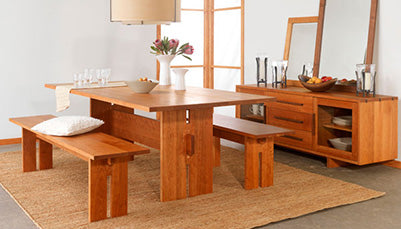At Vermont Woods Studios, we celebrate timeless design, natural materials, and the legacy of furniture makers who changed the way we interact with wood. Our Modern American Collection—featuring natural cherry wood with elegant walnut accents—was inspired in part by the visionary work of George Nakashima, whose reverence for nature, craft, and form continues to shape modern furniture design.
But who was George Nakashima? We dive in deeper below.
About George Nakashima
George Nakashima (1905-1990) was an architect, designer, and woodworker that was a driving force behind 20th-century furniture innovation. The aesthetic of his furniture can be described as a unique mix of European Modernism with Japanese woodwork. Elements woven through his body of work can also be attributed to the influence of his love of nature, formal education in architecture, and his time spent in India.
Nakashima practiced during the mid-20th century, but his work was a divergence from most of the other designers of that period. Whereas many designers during the time looked to incorporate new materials like metal, plastic, plywood, and glass into their designs, Nakashima preferred to work with solid, natural wood. No doubt his relationship with Antonin Raymond, a protege of Frank Lloyd Wright (the father of “Organic Architecture”), influenced this propensity.
Nature's Guiding Hand
"I'm essentially a druid. I believe that there are ghosts in trees, and in a very deep sense the tree is more God-like than man..."-George Nakashima
Of Japanese descent, Nakashima was born in 1905 in Spokane, Washington and became enamored by the beauty of nature at a young age. It was the camping trips and hikes that he participated in through Boy Scouts that kickstarted his love of nature, particularly trees. This love continued throughout his life and had an integral role in his approach to art and design.
Architecture: A Step into the World of Design
Not unlike Adrian Pearsall and many other furniture designers prominent in the mid-1900s, Nakashima originally trained to be an architect. He graduated from the University of Washington in 1929 with a degree in architecture and then got a Masters in 1931 through M.I.T. Soon after, George found work as an architectural designer and mural painter for the Long Island State Park Commission.
However, when the Great Depression seized America, like so many other Americans, he found himself out of work. He then made a bold move that would change his life forever—he sold his car for a round-the-world steamship ticket, which led him to France, North Africa, and finally, Japan. In Japan, he began work for the well-known architect Antonin Raymond—a protégé of Frank Lloyd Wright that worked with Wright designing the Imperial Hotel. Nakashima toured Japan extensively while working for Raymond and studied the intricacies of Japanese architecture and design. It was also here that he met Marion Okajima, who coincidentally was also from Seattle and was abroad teaching English. They would later marry back in the States in 1941 and in 1942, have a daughter, Mira.
The Sri Aurobindo Ashram: A Spiritual Influence
In 1937, a work trip took George to India to be a primary construction consultant for the Golconde Dormitory at the Sri Aurobindo Ashram—the first modernist building in India. The building had a minimal design that harmonized the exterior and interior and only incorporated what was essential for life within. It was styled after Modernist architect Le Corbusier's international style, complete with rectangular forms with flat and smooth surfaces free of embellishment.
During his two years working on this project, Nakashima also became part of the Sri Aurobindo Ashram and was re-christened with the Sanskrit name Sundarananda— "the one who delights in beauty." After this project, he left his architectural career behind to pursue his love of furniture. Architecture in America at the time was transitioning to industrialization and modernity, beginning to shun manual skill. By turning to furniture, George was able to uphold his standards and explore traditional philosophies and craftsmanship instead—two factors that heavily contribute to making his work so iconic.
Japanese Internment & Woodworking

A Japanese hand plane called a Kanna. While many Craftsmen push wood planes away from them, Japanese woodworkers would draw this plane toward them. Source
Upon returning to the States in 1940, Nakashima continued to explore making furniture while also teaching woodwork in Seattle. However, this only lasted a short time with World War ll amping up. After Roosevelt signed Executive Order 9066—an order establishing internment camps for anyone of Japanese heritage— George, along with his wife and daughter, were interned at Camp Minidoka in Idaho in 1942.
There he met a man skilled at the art of Japanese carpentry, Gentaro Hikogawa. With Hikogawa's guidance, Nakashima was able to refine his furniture building skills using traditional Japanese hand tools and joinery techniques. This type of carpentry taught him to be patient, have discipline, and strive for perfection. Furniture making in this form is never a race, but rather a skillful journey. The butterfly joints he learned during this time later become part of George's signature style. In 1943 the Nakashima family was finally released from the camp under the sponsorship of Antonin Raymond.
Nakashima Furniture
Set up with a new studio on Raymond's farm in New Hope, Pennsylvania, George started his furniture business. At first, his business grew slowly while he further honed his skills and produced pieces like the Straight Back Chair for Knoll and private commissions for Widdicomb- Mueller. This incremental growth continued until 1973 when Nelson Rockefeller commissioned 200 pieces for his house in Pocantico Hills, New York. The aesthetic of Nakashima's furniture was the cumulation of both his training and life experiences. It was defining for the American Crafts era and often had common elements strung throughout. His signature style often included:
Minimal Designs
His body of work focused on craftsmanship and quality materials. His creations were often simple, allowing the natural intricacies of the wood and materials to take center stage. He firmly believed it was a craftsman's job to highlight the unique qualities of a piece of wood, not to work against them.
Imperfect Wood
His work fell much in line with the Japanese philosophy of Wabi-Sabi, highlighting and embracing the flaws of nature—cracks, holes, knots, burls, figured grain. While some craftsmen may find imperfect materials limiting, Nakashima felt quite the opposite. He aimed to celebrate the individuality of the wood as he thought these imperfections revealed the soul of the tree.
"Each flitch, each board, each plank can have only one ideal use. The woodworker, applying a thousand skills, must find that ideal use and then shape the wood to realize its true potential."
Butterfly Joinery
A traditional Japanese carpentry skill learned from Gentaro Hikogaw at a Japanese intern camp. Also called a dovetail key or bowtie, this inlay is often used to mend cracks in wood and prevent them from splitting further. It produces a bowtie or butterfly shape on the wood's surface, hence the name. This allowed for items made out of imperfect wood to be functional with minimal intervention from the furniture maker and was particularly prominent on his live edge tables.
Signed Boards
While some furniture makers finish off their pieces with their signature, Nakashima was known to sign boards with his client's name. He had a close working relationship with many of his clients and after the boards were handpicked, they got signed with their name in ink.
Nakashima Today
After he died in 1990, the furniture business was taken over by George's daughter, Mira. Mira worked with her father since 1970 and still runs the company today, offering a mix of George's designs, as well as her own. You can also find his furniture on display at many museums, including the Metropolitan Museum of Art, the Renwick Gallery at the Smithsonian, the Michener Art Museum, and the Philadelphia Museum of Art.
Nakashima's designs not only helped define the era of Craftsman Furniture, but demonstrates the beauty in embracing nature's offerings, flaws and all. It paved the way for many collections of Asian-inspired furniture, as well as specific styles like live edge.
If you're drawn to Nakashima’s philosophy and aesthetic, be sure to explore our Modern American Collection. Each piece is crafted from sustainably sourced cherry wood and accented with black walnut—a subtle but intentional nod to Nakashima’s love of contrasting natural tones. We work with Vermont artisans who share his commitment to honoring the wood, using traditional joinery techniques and hand-applied finishes.


